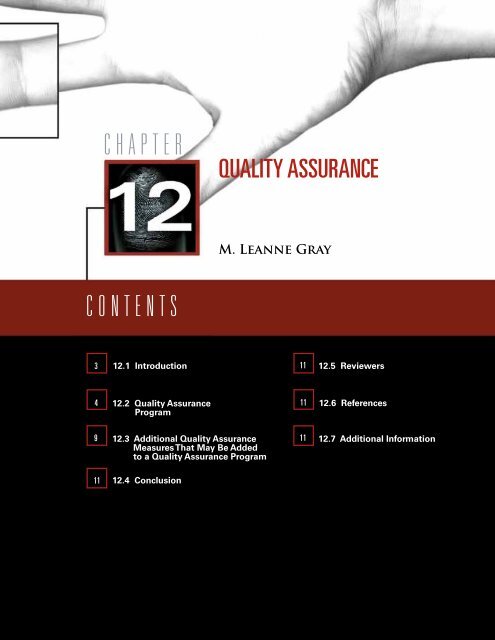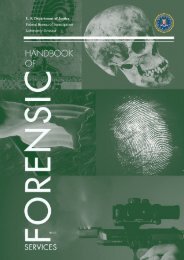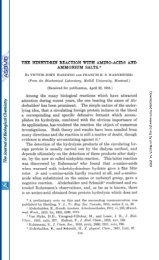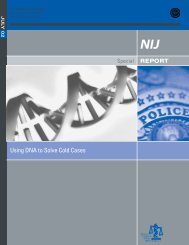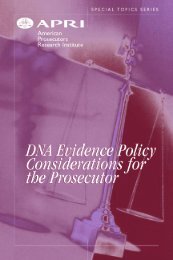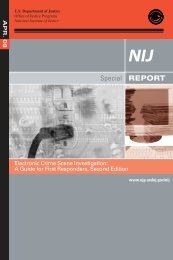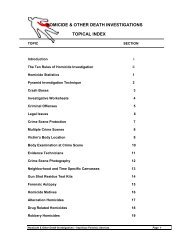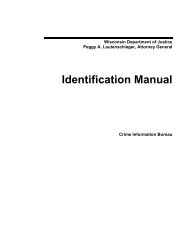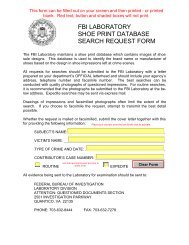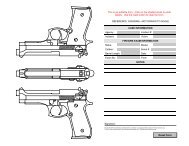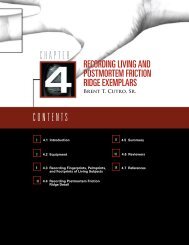Chapter 12 - Quality Assurance - Imprimus Forensic Services
Chapter 12 - Quality Assurance - Imprimus Forensic Services
Chapter 12 - Quality Assurance - Imprimus Forensic Services
- No tags were found...
You also want an ePaper? Increase the reach of your titles
YUMPU automatically turns print PDFs into web optimized ePapers that Google loves.
C h a p t e r<strong>Quality</strong> assuranceM. Leanne GrayC O N t e N t S3<strong>12</strong>.1 Introduction11<strong>12</strong>.5 Reviewers4<strong>12</strong>.2 <strong>Quality</strong> <strong>Assurance</strong>Program11<strong>12</strong>.6 References9<strong>12</strong>.3 Additional <strong>Quality</strong> <strong>Assurance</strong>Measures That May Be Addedto a <strong>Quality</strong> <strong>Assurance</strong> Program11<strong>12</strong>.7 Additional Information11<strong>12</strong>.4 Conclusion
<strong>Quality</strong> <strong>Assurance</strong>c h a p t e r 1 2<strong>Chapter</strong> <strong>12</strong><strong>Quality</strong> assuranceM. Leanne Gray<strong>12</strong>.1 IntroductionThe purpose of a quality assurance program is to ensurethat all examiners meet the quality standards set by thediscipline and by the individual laboratory. A quality assur-ance program includes “those planned and systematicactions necessary to provide sufficient confidence that alaboratory’s product or service will satisfy given requirementsfor quality” (ASCLD/LAB, 2005, p 66). A qualityassurance program sets the guidelines for developmentand implementation of standards that address examinerqualifications, report writing, document control, qualitycontrol measures, procedural validation and documentation,organizational structure, infrastructure requirements,and evidence control.There are two fundamental principles in friction ridge examination:(1) all latent print examiners must be trained andfound to be competent to perform casework prior to beginningindependent casework, and (2) all individualizations(i.e., identifications) must be verified by another competentand qualified examiner (SWGFAST, 2006, p <strong>12</strong>2).The processing of evidence to develop and preserve latentprints can involve various processing techniques and preservationmethods. Although no standard sequence can beapplied to all items to be processed, standardized sequenceswithin an agency should be established for particular cir-cumstances (e.g., type of evidence, type of case). Frictionridge examination requires that an examiner analyze anddetermine the suitability of the ridge detail, compare theridge detail with known exemplars, and evaluate the sufficiencyof visual information to reach a conclusion. Possibleconclusions are individualizations (identifications), exclusions,or inconclusives (SWGFAST, 2004, pp 358–359).<strong>Quality</strong> issues that arise from inconsistencies, clerical oradministrative errors, or erroneous conclusions may occur.<strong>12</strong>-3
c h a p t e r 1 2 <strong>Quality</strong> <strong>Assurance</strong>A quality assurance program will allow for the tracking ofany of these quality issues. A quality assurance programwill ensure that all examiners are following proper protocolin order to minimize the number of issues that areproduced.Because the forensic science community is constantlygrowing and changing, and, therefore, the rules governingquality assurance continue to change, this chapter willdiscuss generalities of a quality assurance program. Forspecific guidelines and the most up-to-date resources,please refer to the appendix of related references on qualityassurance programs and accreditation and certificationorganizations, section <strong>12</strong>.6.<strong>12</strong>.2 <strong>Quality</strong> <strong>Assurance</strong> Program<strong>12</strong>.2.1 <strong>Quality</strong> <strong>Assurance</strong> DocumentsA quality assurance program should be written and containedin a set of documents or in a single document (e.g.,quality manual). Included in the quality manual shouldbe documentation for the following areas: processingtechniques; preparation, use, and storage of chemicals;laboratory safety procedures; material safety data sheets;evidence handling procedures; proficiency testing; minimumnotation requirements on examination worksheets;report wording guidelines; technical and administrativecase reviews; training and competency records; equipmentcalibration and maintenance logs; validation records; policyand procedure manuals for electronic fingerprint systems;and testimony reviews (SWGFAST, 2006, pp 117–118).A quality manual should also outline the responsibilitiesof personnel regarding adherence to the quality assuranceprogram and delineate the procedures to follow when dealingwith quality issues. In addition, documents may addresssuch areas as minimum standards and controls, qualificationsof a verifier, organization and management requirements,personnel requirements, and facility requirements.<strong>12</strong>.2.2 Competency TestingAn agency must have a method to initially test for competencywhen an examiner first joins the agency or anexaminer completes an internal training program. This initialcompetency testing may include oral, written, or practicaltests. If an agency is large and has multiple worksites, anyrequired tests should be consistent from one worksiteto another. This will ensure that each examiner’s overallquality and minimum level of competency are consistentthroughout the agency. No examiner should be allowed tobegin independent casework until he or she has satisfiedall aspects of the initial competency testing phase.<strong>12</strong>.2.3 Evidence Handling and <strong>Quality</strong> AuditsEach agency must establish a policy for the handling ofall evidence within its control. A chain of custody shall bemaintained from the time that the evidence is collected orreceived until it is released. Procedures shall establish howevidence is collected, received, and stored. The proceduresshall preserve the identity, integrity, condition, and securityof the item. The policy should include information abouthow evidence is to be packaged, seal requirements, andwhat to do when evidence is lost or if there is a discrepancy.Included in this policy should be periodic audits ofall evidence within the agency’s control. The time framefor these audits to occur (e.g., monthly, quarterly, semiannually,or annually), as well as what percentage ofevidence will be examined and who will conduct the audit,should be established.In addition, an agency should establish a policy for auditingall other aspects of the agency’s quality system, includinga time frame for these audits to occur as well as who willconduct these audits. An agency may choose to bring inauditors from outside agencies or have internal auditorsconduct the inspections.<strong>12</strong>.2.4 Preparation, Use, and Storageof ChemicalsAn agency must have a policy in place describing properprocedures for preparation, use, and storage of all chemicalsthat are maintained within the agency. This policy mayaddress such issues as markings required on the chemicalswhen received, length of time a chemical can be kept andused if commercially purchased, shelf life of each reagentsolution that is prepared within the agency, and a list ofchemicals and reagent solutions that must be tested priorto use with casework. An agency should create and maintaina list of all chemicals and reagent solutions that areused in each section of the agency. In addition, an agencyshould have a plan for proper disposal of chemicals andreagent solutions, including contact information for anyoutside vendors that may be needed to implement the disposalof outdated or no longer used chemicals or reagentsolutions.<strong>12</strong>–4
<strong>Quality</strong> <strong>Assurance</strong>c h a p t e r 1 2<strong>12</strong>.2.5 Processing TechniquesAn agency must have a policy in place to delineate whatvalidated processing techniques are sanctioned by theagency. Any changes, updates, or deletions to a processingtechnique must be made available to all agency examiners.An agency may wish to include a guideline for examinersto follow that details what processing techniques are appropriateat each step of an examination. However, any listshould be viewed as merely a guide.<strong>12</strong>.2.6 Policies and Procedure Manualsfor Electronic Fingerprint SystemsAn agency must have policies and procedure manualsdelineating the requirements for use, maintenance, and updatesto any electronic fingerprint systems that are accessibleto examiners within the agency. These policies andprocedure manuals should be reviewed routinely to ensurethat any changes, updates, or deletions are current.These policies and procedure manuals may include, butare not limited to, such things as training that an examinermust successfully complete prior to having accessto the electronic fingerprint system(s); documentationrequirements, such as paperwork or images that must bemaintained; and report wording requirements when anelectronic fingerprint system is used in casework.<strong>12</strong>.2.7 Examination ProceduresAn agency must establish procedures for the processingand examination of evidence, note taking, and reportwriting. These procedures should describe established protocolsand types of examinations performed. Additionally,they shall require that at the time of collection (whether inthe field or in the laboratory), all latent print evidence shallbe marked with minimal information (i.e., a unique caseidentifier, personal markings) and when relevant, informationto explain the orientation or position of the latent. Thesubstrate information should also be included. This mayinclude the use of a diagram.An agency must establish procedures for the comparisonof friction ridge detail (SWGFAST, 2002, p 324). These proceduresshould describe established protocols (e.g., Areall latents to be compared or should the comparisons beconcluded after the first latent is individualized?).<strong>12</strong>.2.8 VerificationAn agency should establish rules governing the qualificationsthat are needed to be a verifier. These qualificationsmay include a minimum number of hours of training, aminimum number of continuing education credits, or a minimumnumber of cases completed without quality issues.It is important to remember that, when setting a standardfor the qualifications of a verifier, the number of years ofservice is not as important as the quality of work that hasbeen produced.<strong>12</strong>.2.8.1 Verification. Verification of a latent print comparisonis “the confirmation of an examiner’s conclusion byanother competent examiner” (SWGFAST, 2006, p <strong>12</strong>2).An agency must establish rules governing the verificationprocess. These rules may be limited to individualizationsbut may also include exclusions or inconclusives.<strong>12</strong>.2.8.2 Blind Verification. “Blind verification is the confir-mation of an examiner’s conclusion by another competentexaminer who has no expectation or knowledge of theprior conclusion” (SWGFAST, 2006, p <strong>12</strong>2). This processwould require that the initial case examiner not place anymarkings of any kind, including conclusion notations, onany of the evidence needed for the verification examination,thus assuring that another examiner given the sameevidence will be unaware of the initial examiner’s findings.The Scientific Working Group on Friction Ridge Analysis,Study and Technology (SWGFAST) recommends blind verification“in cases involving an individualization, exclusion,or inconclusive of a person based on only a single latentprint” (SWGFAST, 2006, p <strong>12</strong>2). An agency should establishpolicies regarding what cases require using a blind verificationprocess.<strong>12</strong>.2.9 Conflict ResolutionBecause of the inherent variables (e.g., skill, experience)and the possibility of examiner error, an examiner anda subsequent verifier may provide results that are notconsistent. An agency shall define what constitutes aninconsistency and conduct a quality review to resolve allinconsistencies in examination results.The quality review must ensure that all policies are followedand that personal preferences are not allowed totake precedence over minimum standards and controls<strong>12</strong>-5
<strong>Quality</strong> <strong>Assurance</strong>c h a p t e r 1 2A quality assurance program should set parameters forinternal proficiency tests, including that they shall containmultiple latent friction ridge impressions and known standards(SWGFAST, 2009, p 678). These parameters may alsoinclude the additional requirement of evaluating nonsuitableprints.<strong>12</strong>.2.11.2 External Proficiency Tests. The use of a commerciallyprepared external proficiency test has the advantageof being nonbiased because the agency purchasingthe test has no input into the makeup of the test and noadvance notice of the test answers prior to submission ofthe test for grading. External proficiency testing ensuresthat the examiner is compared against the manufacturer’svalidated results. The results can also be compared withthe results of other test takers.<strong>12</strong>.2.11.3 Blind Proficiency Tests. An agency may useblind proficiency tests to verify the quality of an examiner’swork without his or her knowledge. The agency may gener-ate mock evidence and then assign it as a regular case. Thecase examiner may never know that he or she worked ablind proficiency test, unless the quality of work that wasproduced required a quality review.<strong>12</strong>.2.11.4 Double-Blind Proficiency Tests. Having anotheragency submit mock evidence as a regular case can providea double-blind test to evaluate the performance of theindividual(s) completing the case and the agency’s overallperformance with respect to that case.<strong>12</strong>.2.<strong>12</strong> Technical Case ReviewA technical case review is a useful tool to regularly determinethe quality of casework and ensure reliable results. An agencymust establish what constitutes a technical review, who shallconduct technical case reviews, and the frequency of thereviews.The American Society of Crime Laboratory Directors/Laboratory Accreditation Board (ASCLD/LAB) defines a technicalreview as a “review of notes, data and other documentswhich form the basis for scientific conclusion” (ASCLD/LAB,2005, p 68). SWGFAST further explains that “these reviewsconcentrate on whether the appropriate tests and examinationshave been performed to support the results andconclusions reported and on whether sufficient supportingdocumentation is present. They also focus on whether theconclusions are consistent with the documentation and arewithin accepted practices”. (SWGFAST, 2006, pp <strong>12</strong>4–<strong>12</strong>5).A technical review may include a partial or completereworking of the case, and, therefore, technical casereviews must be conducted by another qualified latentprint examiner.<strong>12</strong>.2.13 Administrative ReviewAn agency must establish what constitutes an administrativereview and who shall conduct administrative reviews.ASCLD/LAB defines an administrative review as “a procedureused to check for consistency with laboratory policyand for editorial correctness” (ASCLD/LAB, 2005, p 61).SWGFAST indicates that “administrative reviews shall beconducted by a supervisor or designee” (SWGFAST, 2006,p <strong>12</strong>5). An administrative review may include reviewing alldocumentation within a case file for technical accuracy ormay simply be a review of the documentation verifying thatno clerical errors, such as typographical errors, are on theworksheet or written report.An agency must have a mechanism in place for dealingwith cases in which an administrative review identifies aquality issue. If the issue is minor, then communicationbetween the reviewer and the original case examiner maybe sufficient to correct the issue. If the issue is majorand the individual conducting the administrative review isnot management, then management should be notifiedimmediately. Management should then notify the qualitymanager and the quality reviewer (when applicable) to begina formal review process to determine whether the erroris singular in nature or systemic.An agency may outline specific provisions in the qualitymanual regarding confidentiality when dealing with issues.An examiner identified as having an issue has a right forthat issue not to become public knowledge among his orher coworkers. If nonmanagement personnel discover aquality issue, the agency may mandate that the originaladministrative reviewer cease involvement in any additionalquality reviews that result from the initial issue being identified.In addition, the administrative review examiner shouldbe required to maintain confidentiality regarding the issueand the original case examiner indefinitely, unless givenspecific permission by management to discuss these facts.<strong>12</strong>.2.14 Testimony ReviewEach agency should have a mechanism in place to reviewthe testimony of each examiner within that agency.SWGFAST recommends that testimony reviews be done<strong>12</strong>-7
c h a p t e r 1 2 <strong>Quality</strong> <strong>Assurance</strong>annually (SWGFAST, 2006, p <strong>12</strong>6). This review shouldencompass both the technical accuracy of the testimonyand the overall presentation and ability of the examiner toprovide an accurate and articulate accounting of all examinationsconducted and any conclusions or opinions noted.An agency may require that the reviewer be a manager(preferably one with a background in the specialty beingtestified to), an individual from the training department(when applicable), or a peer. An agency may allow for a ver-bal or written contract with court officials. An agency mayalso incorporate the use of a preprinted evaluation surveycontaining specific questions that can be provided to eitheror both of the attorneys involved, as well as the judge, asanother means of determining the quality of the testimonyprovided by the examiner.<strong>12</strong>.2.15 Corrective ActionIt may be necessary to take corrective action to remedyan issue related to the quality of the work product andto prevent further related issues. An agency must have ageneral description of what corrective action is appropriateaccording to the type of issue identified. This correctiveaction may include such options as removing an examinerfrom casework responsibility, a review of prior casework,requiring an examiner to receive and complete additionaltraining in the area the issue was made, or reviewing additionalcasework completed by the examiner to determinewhether the issue was singular in nature or systemic.Corrective actions should not be construed as disciplinaryactions. They are an important part of any quality review todetect and remedy any errors or issues relating to the qualityof the work product.<strong>12</strong>.2.16 Laboratory Safety ProceduresEach agency must establish safety procedures and policiesfor its system. The safety procedures and policies shouldbe in compliance with Occupational Safety and HealthAdministration (OSHA) and state regulations. The safetyprocedures and policies should include such areas as per-sonal protective equipment use, safe storage and disposalof chemicals, and how access to the facility is controlled.(See also section <strong>12</strong>.2.4 on storing chemicals.) An agencymay wish to include policies on blood-borne pathogens andchemical hygiene in its safety procedures.<strong>12</strong>.2.16.1 Designation of a Safety Manager. An agencyshould designate a safety manager (irrespective of otherresponsibilities) who “has the defined authority andobligation to ensure that the requirements of the safetysystem are implemented and maintained” (ASCLD/LAB,2005, p 67). Policies should be stated regarding the scopeand depth of responsibilities for the safety manager.The requirements for and duties expected of the safetymanager should be outlined in the safety documents andmay contain such information as the qualifications of thesafety manager; time limits, if any, that a person shall bedesignated as safety manager; reviewing and updating anywritten safety policies; disseminating all safety policies andupdates to all examiners and management; maintaining allsafety records; tracking all safety issues; and producing awritten report annually detailing the safety record of theagency.<strong>12</strong>.2.16.2 Material Safety Data Sheets. Material safetydata sheets are provided by or can be acquired from allcompanies selling chemicals. Each agency must design aprogram for the collection, storage, and maintenance ofthe material safety data sheets for all chemicals purchasedor used within the agency. Material safety data sheetsprovide vital safety information about chemicals and are avaluable tool to maintain safety within an agency.<strong>12</strong>.2.17 Equipment Calibration andMaintenancePerformance checks are used by agencies to ensure thatequipment and instruments are functioning to establishedcriteria. An agency must establish a system to verify thateach piece of analytical equipment is examined regularly toensure proper working order. All equipment that requirescalibration should have written documentation, such as alogbook, to verify the date that the equipment was examined,the person or business that examined the equipment,and any adjustments or calibrations that were performedon that instrument. An agency may establish a schedulethat requires regular internal inspections, such as quarterlyreviews, and an annual external review.<strong>12</strong>.2.18 Method Validation RecordsEach processing procedure must be validated and documentationmust be maintained prior to use in casework.An agency must establish internal minimum standardsfor the validation process and sequence of processing<strong>12</strong>–8
<strong>Quality</strong> <strong>Assurance</strong> c h a p t e r 1 2techniques. An agency may decide to accept an outsideagency’s published validation study. An agency may adoptanother agency’s or laboratory’s procedure but must stilldemonstrate the protocol works as intended. This meansthat the agency must demonstrate that agency examinersusing available equipment and instruments can achieve theestablished requirements.Processing techniques should be reviewed periodically toensure that the techniques are current and still effective.This review will allow for updates and revisions to be madeto the processing procedure. Each agency must establishan appropriate time frame for these reviews (e.g., one year,five years).<strong>12</strong>.2.19 Continuing EducationAn agency should create and maintain a policy outliningand encouraging all examiners to pursue additional educationalopportunities. These educational opportunities mayinclude such coursework as undergraduate or postgraduateclasses or degrees, academic or service-related seminars,and educational conferences provided by professionalorganizations (e.g., the International Association for Identification(IAI), the Canadian Identification Society, and theFingerprint Society).An agency may wish to include in this policy the trackingof individual requests or attendance at any of the abovementionedcontinuing education opportunities. By trackingthese requests and attendance records, an agencymay better identify which individuals strive to further theirknowledge about their profession, which may be acknowledgedduring a performance review.<strong>12</strong>.3 Additional <strong>Quality</strong> <strong>Assurance</strong>Measures That May Be Added to a<strong>Quality</strong> <strong>Assurance</strong> ProgramIn addition to the basic components, an agency can addother components to its quality assurance program.<strong>12</strong>.3.1 <strong>Quality</strong> ManagerA quality assurance program may have one individual who“has the defined authority and obligation to ensure that therequirements of the quality system are implemented andmaintained” (ASCLD/LAB, 2005, p 66). In a large organization,this person may have the job title of quality managerand this may be his or her primary function at that agency.For smaller agencies, the quality manager may be a parttimeposition. The quality manager may have caseworkresponsibilities along with managing the quality assuranceprogram.It is important that an agency document the specificrequirements and duties expected of this position. Thesemay include, but are not limited to, qualifications of thequality manager; time limits, if any, that a person shall bedesignated as quality manager; reviewing and updating thequality manual; disseminating quality assurance programpolicies and updates to all examiners and management;completing all case file reviews or overseeing the work producedby quality reviewers; maintaining all quality records;tracking all quality issues; and producing a written reportannually detailing the quality record of the agency.<strong>12</strong>.3.2 Minimum Standards and ControlsAn agency may establish a set of minimum standardsand controls to ensure that all analysts within the agencyunderstand exactly what is expected regarding the qualityof casework being produced. These minimums shouldbe clear and precise to allow for easy understanding andshould include all requirements for evidence handling,evidence examination, evidence preservation, examinationdocumentation, evidence disposition, and report wording.If an agency establishes minimum standards and controls,it must establish a policy for reevaluating them. Thisreevaluation should include a timetable to ensure that allstandards and controls are accurate and current with generallyaccepted scientific practices.Minimum standards and controls for each aspect ofcasework should be documented either in the agency’squality manual or in the agency’s procedures manual, whenapplicable.<strong>12</strong>.3.3 Organization and ManagementRequirementsAn agency may establish organization and managementrequirements for all staff members. Organization andmanagement requirements may include the delineationof organizational structure, administrative practices, anddelegation of authority. Organization and managementrequirements should be documented either in the agency’squality manual or in the agency’s overall policy manual.<strong>12</strong>-9
c h a p t e r 1 2 <strong>Quality</strong> <strong>Assurance</strong><strong>12</strong>.3.4 Personnel RequirementsAn agency may establish personnel requirements for allstaff members. These requirements may include minimumeducational requirements, specific undergraduate or postbaccalaureateclass-specific requirements, and employeedevelopment by attending professional organization meetingsand seminars. Personnel requirements should bedocumented either in the agency’s quality manual or in theagency’s overall policy manual.<strong>12</strong>.3.5 Facility RequirementsAn agency should ensure that the working facility isdesigned for maximum case productivity while maintainingthe highest level of safety available. This policy shouldaddress safety showers, eye wash stations, fire extinguishers,fume hood air flow requirements, and time frames forverifying the working condition of these safety features.In addition, a facility requirement policy should containspecific time frames and conditions, such as the minimumnumber of staff required onsite to ensure the safety ofstaff when engaging in certain activities, such as chemicalprocessing or laser examination. Specific safety requirementsand guidelines can be found by contacting OSHA.State regulations should also be identified and followed.Facility requirements should be documented either in theagency’s quality manual, safety manual (if such a manualexists), or overall policy manual.<strong>12</strong>.3.6 Use of External Laboratory <strong>Services</strong>Agencies may find it necessary, because of large backlogsor the inability to perform a specific service, to pursue theuse of external laboratory services. If that is the case, itis the agency’s responsibility to ensure that any externallaboratory service with which it initiates a contract adheresto all of the agency’s quality assurance policies and proceduresregarding all aspects of casework, including evidencehandling and evidence processing.<strong>12</strong>.3.7 Agency Accreditation andCertificationExaminer certification and laboratory accreditation havebecome demonstrative measures of quality within theforensic disciplines. These programs have been promoted toprovide the criminal justice system with generally acceptedmethods for quality assurance. Examiner certification demonstratesa level of competency and ability for the individual,and accreditation demonstrates agency compliance withaccepted policies and procedures for quality assurance.<strong>12</strong>.3.7.1 International Association for Identification —Latent Print Certification Program. The IAI establishedthe program in 1977. This certification program requires aminimum of two years’ experience and a bachelor’sdegree. (Years of experience can be substituted for theeducational requirement.) Basic testing requirementsinclude a written test, a fingerprint pattern interpretationtest, and a comparison test.<strong>12</strong>.3.7.2 American Society of Crime LaboratoryDirectors/Laboratory Accreditation Board (ASCLD/LAB) Legacy Program. The ASCLD/LAB Legacy Programhas an extensive process to accredit agencies. This accreditationprocess involves reviewing an agency’s written policies,procedures, and casework and then inspecting thatagency to confirm that it is following minimum accreditationstandards and the policies it has set forth. ASCLD/LABevaluates an agency according to three criteria: essential,important, and desirable. The definition of essential is“standards which directly affect and have fundamental impacton the work product of the laboratory or the integrityof the evidence” (ASCLD/LAB, 2005, p 63). The definitionof important is “standards which are considered to be keyindicators of the overall quality of the laboratory, but maynot directly affect the work product nor the integrity of theevidence” (ASCLD/LAB, 2005, p 64). The definition of desir-able is “standards which have the least affect on the workproduct or the integrity of the evidence but which never-theless enhance the professionalism of the laboratory”(ASCLD/LAB, 2005, p 63).In addition, ASCLD/LAB has set new standards on manyissues that continue to push the forensic community to ahigher level of quality. An ASCLD/LAB accreditation mustbe renewed every five years. This renewal involves thesame process as the initial accreditation process and isoutlined extensively by ASCLD/LAB in its manual.<strong>12</strong>.3.7.3 International Organization for Standardization(ISO). ISO works in conjunction with the InternationalElectrotechnical Commission (IEC) to create a worldwidestandardization system. ISO is the world’s largest developerof standards. ISO’s principal activity is the developmentof technical standards. ISO has created a technical standard(17025) for any testing and calibration laboratory; thisstandard is applicable to forensic laboratories. The functionof ISO does not include accreditation programs. It sets<strong>12</strong>–10
<strong>Quality</strong> <strong>Assurance</strong> c h a p t e r 1 2standards that allow agencies to pursue ISO accreditationthrough accrediting bodies. Currently, ASCLD/LAB and<strong>Forensic</strong> <strong>Quality</strong> <strong>Services</strong> (FQS) have programs that allowforensic agencies to pursue accreditation that is based onISO/IEC standard 17025.The ASCLD/LAB International Accreditation Program isbased on the requirements of ISO/IEC 17025, plus supplementalrequirements that are based on the InternationalLaboratory Accreditation Cooperation (ILAC) Guide 19(Guidelines for <strong>Forensic</strong> Science Laboratories) and theASCLD/LAB Legacy Program requirements.<strong>Forensic</strong> <strong>Quality</strong> <strong>Services</strong>-International’s (FQS-I) accreditationprogram is based on the requirements of ISO/IEC17025, ILAC Guide 19, and FQS-I field-specific criteria. Thefield-specific criteria include “<strong>Forensic</strong> Requirements forAgencies that Perform Latent Print Testing”, developed bya technical advisory committee of latent print examinersspecifically for the FQS-I program (FQS-I, 2006).<strong>12</strong>.4 ConclusionThe forensic science community must continue to push forhigher standards of forensic excellence. An examiner mustalways remember that the work produced in a forensicagency has the potential to have a dramatic effect, not onlyon a suspect in a criminal case, but also on the victim andboth the suspect’s and victim’s families. As examiners, weowe it to the community we serve to produce a qualitywork product each time we work a case, no matter whatthe offense.<strong>12</strong>.5 ReviewersThe reviewers critiquing this chapter were Patti Blume,Deborah Friedman, Alice Maceo, Kenneth O. Smith, Jr.,Lyla A. Thompson, and Juliet H. Wood.<strong>12</strong>.6 ReferencesAmerican Society of Crime Laboratory Directors/LaboratoryAccredition Board. ASCLD/LAB Manual. ASCLD/LAB:Gamer, NC, 2005.Byrd, J.; Bertram, D. Form-blindness. J. <strong>Forensic</strong> Ident.2003, 53 (3), 315–341.<strong>Forensic</strong> <strong>Quality</strong> <strong>Services</strong>-International. <strong>Forensic</strong> Requirementsfor Agencies that Perform Latent Print Testing.FQS-I: Largo, FL 2006.Scientific Working Group on Friction Ridge Analysis, Studyand Technology (SWGFAST). Friction Ridge ExaminationMethodology for Latent Print Examiners. J. <strong>Forensic</strong> Ident.2002, 52 (3), 324–328.SWGFAST. Standards for Conclusions. J. <strong>Forensic</strong> Ident.2004, 54 (3), 358–359.SWGFAST. <strong>Quality</strong> <strong>Assurance</strong> Guidelines for Latent PrintExaminers. J. <strong>Forensic</strong> Ident. 2006, 56 (1), 117–<strong>12</strong>7.SWGFAST. Guidelines for Latent Print Proficiency TestingPrograms. J. <strong>Forensic</strong> Ident. 2009, 59 (6), 677–680.<strong>12</strong>.7 Additional InformationArter, D. R. <strong>Quality</strong> Audits for Improved Performance, 3rded.; ASQ <strong>Quality</strong> Press: Milwaukee, WI, 2003.Bauer, J. E.; Duffy, G. L.; Westcott, R. T., Eds. The <strong>Quality</strong>Improvement Handbook, 2nd ed.; ASQ <strong>Quality</strong> Press:Milwaukee, WI, 2006.Benbow, D. W.; Elshennawy, A. K.; and Walker, F. TheCertified <strong>Quality</strong> Technician Handbook; ASQ <strong>Quality</strong> Press:Milwaukee, WI, 2003.Clark, T. J. Success Through <strong>Quality</strong>: Support Guide for theJourney to Continuous Improvement; ASQ <strong>Quality</strong> Press:Milwaukee, WI, 1999.Crosby, P. B. Philip Crosby’s Reflections on <strong>Quality</strong>;McGraw-Hill: New York, 1996.Crosby, P. B. <strong>Quality</strong> Is Free; McGraw-Hill: New York, 1979.Crosby, P. B. <strong>Quality</strong> Is Still Free; McGraw-Hill: New York,1996.Griffiths, D. N. Management in a <strong>Quality</strong> Environment; ASQ<strong>Quality</strong> Press: Milwaukee, WI, 1995.Hartman, M. G., Ed. Fundamental Concepts of <strong>Quality</strong>Improvement; ASQ <strong>Quality</strong> Press: Milwaukee, WI, 2002.Okes, D.; Westcott, R. T., Eds. The Certified <strong>Quality</strong> ManagerHandbook, 2nd ed; ASQ <strong>Quality</strong> Press: Milwaukee,WI, 2000.<strong>12</strong>-11
c h a p t e r 1 2 <strong>Quality</strong> <strong>Assurance</strong>Russell, J. P. The Internal Auditing Pocket Guide; ASQ <strong>Quality</strong>Press: Milwaukee, WI, 2003.Russell, J. P., Ed. The ASQ Auditing Handbook, 3rd ed.;ASQ <strong>Quality</strong> Press: Milwaukee, WI, 2006.Singer, D. C., Ed. A Laboratory <strong>Quality</strong> Handbook of BestPractices and Relevant Regulations; ASQ <strong>Quality</strong> Press:Milwaukee, WI, 2001.Singer, D. C.; Upton, R. P. Guidelines for Laboratory <strong>Quality</strong>Auditing; Marcel Dekker: New York, 1993.St. Clair, J. Crime Laboratory Management; Elsevier: NewYork, 2003.SWGFAST. Training to Competency for Latent PrintExaminers. http://www.swgfast.org/documents/qualifications-competency/020822_Competency_Latent_2.1.pdf.Tague, N. R. The <strong>Quality</strong> Toolbox, 2nd ed.; ASQ <strong>Quality</strong>Press: Milwaukee, WI, 2004.<strong>12</strong>–<strong>12</strong>


